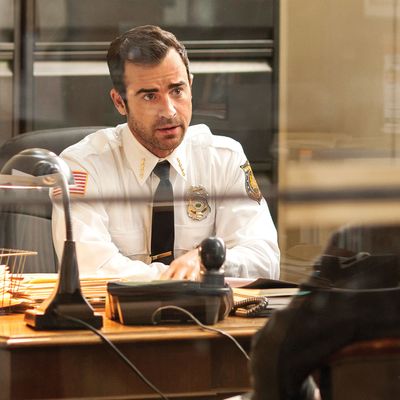
HBO’s The Leftovers missed out on an obvious tagline: “From the co-creator of Lost comes a show about lost souls.” It’s rare to see a whole drama about despair, but that’s what this is: a series wherein an entire species struggles through grief. TV history is filled with shows built around characters who have suffered loss: widows, widowers, orphaned children. In some cases, the lens pulled back to take in extended families (Six Feet Under began with the death of the family’s patriarch) and communities (Twin Peaks was at its heart a show about one murder’s effect on a town). But after The Leftovers—in which a Rapture-like event disappears 2 percent of the world’s population, seemingly at random—I doubt the lens can pull back any farther.
Based on Tom Perrotta’s novel of the same name, and co-created by him and Damon Lindelof, The Leftovers is all bleakness all the time. Parts of it feel as though the show is emotionally blackmailing you into watching: What, don’t you care about these poor, miserable people? Well, go ahead and change the channel then, you monster. The characters wander around in an emotional fog, with good reason: The event was 9/11 multiplied by a couple million. Everyone knew someone who vanished. Many have turned to drugs or alcohol or self-mutilation. Nobody’s giving anybody any breaks because they’re all in pain. Postapocalypse is no time for an ouch contest.
The show starts on the day of the event—October 14—then flashes forward three years. It doesn’t look as though anyone has “moved on.” They’re not just stricken by the magnitude of the loss: They’re angry about the lack of answers. TV news channels debate the religious and philosophical implications: God has a plan; God is just being a jerk; there is no God, etc. A local preacher played by Christopher Eccleston posts flyers identifying vanished people and revealing their sins: gambling, drug dealing, and the like. He seems to be suggesting that the wicked were being punished on October 14; but if that were the case, why did so many infants vanish as well?
Even animals feel the loss. Among the eerier recurring touches are shots of now-stray dogs wandering the show’s suburban– New Jersey landscapes, having been turned wild again by the shock of their owners’ disappearances. The Leftovers’ lead character, police chief Kevin Garvey (Justin Theroux), has nightmares in which he’s tortured or set on fire, and he keeps running into a bald man in a pickup (Michael Gaston of Prison Break) who kills the stray dogs with a rifle. There’s a cult that calls itself the Guilty Remnant, a group that includes Amy Brenneman (whose blank stare has an Ingmar Bergman–like accusatory power). They dress in white, observe vows of silence, silently stalk other characters (including a young woman played by Liv Tyler), and smoke cigarettes to promote the idea that questioning things is a waste of breath. The cultists want to crash a third-anniversary gathering, a decision that the chief is sure will end in violence. He’s against the event anyway because it’s being billed as a “celebration of heroes,” heroes being a synonym for the 98 percent of the population that’s still present. The mayor (Amanda Warren) cynically agrees: “They’re heroes because no one’s gonna come to a parade on ‘We Don’t Know What the Fuck Happened’ Day.”
Throughout the first few episodes, fleeting shots communicate the magnitude of the shock with which the species is still grappling. Some are quietly effective: a deer’s hoof in death spasm; a close-up of a fireplace mantel filled with empty picture frames. Others feel as though Lindelof, Perrotta, and co-producer Peter Berg (Friday Night Lights), who has helmed the first two episodes in his now-familiar bobbing-and-weaving camera style (the show’s action is covered rather than being thoughtfully directed) are forcing moments that might have been more devastating if handled lightly. There’s quite a bit of grandiosely expressive slow motion and instances where characters indulge in actions that an acting teacher might call “indicating,” such as when Garvey impulsively smashes a picture frame and a subsequent one in which his daughter Jill (Margaret Qualley) notices it.
Such scenes might have worked had The Leftovers embraced the black-comedy elements that sometimes bubble up (a TV newscast airs a list of missing celebrities that includes Gary Busey and Shaquille O’Neal), or if it had given up on serious philosophical statements and instead exploited the pulp potential suggested by Paterson Joseph’s ferociously hammy performance as Holy Wayne, an African-American cult leader with a preference for Asian women, a lucrative side business helping legislators “hug away” their pain, and a Kurtz-like ability to attract and hold followers. Though I haven’t read Perrotta’s novel, I’m told there’s a point to all the misery, perhaps even a hint of hope. After all, if humanity can endure and transcend something this horrific, it can endure and transcend anything. If that’s where we’re headed, though, it’s going to be a long, dark road, and I’m concerned there won’t be enough compensatory aesthetic virtues to offset the agony. The first few episodes don’t showcase enough artistry to justify all the slogging and weeping, the bloodied faces and broken hearts. But I’d be lying if I said The Leftovers didn’t fascinate me. The totality of the suffering feels new. The scale of it overwhelms, so much so that nitpicking the dialogue, the performances, or the filmmaking seems petty. This is what I meant by “emotional blackmail,” a certain amount of which is baked right into the show’s premise. The Leftovers practically dares you to keep watching, and feeling. At the bottom of the first page of my notes, “sloppy handheld camerawork” is crossed out. Beneath it is “overwhelming pain.”
*This article appears in the June 16, 2014 issue of New York Magazine.


